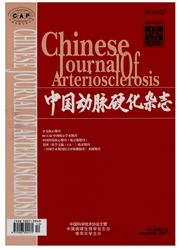

 中文摘要:
中文摘要:
目的 观察急性冠状动脉综合征患者外周血浆氧化型低密度脂蛋白、高敏C反应蛋白、循环内皮细胞计数和一氧化氮的变化,探讨氧化型低密度脂蛋白与高敏C反应蛋白的相关性,以及两者与血管内皮损伤的关系,研究其在急性冠状动脉综合征发生和发展中的意义。方法 急性冠状动脉综合征患者51例,临床及选择性冠状动脉造影排除冠心病20例为对照组。测定外周血浆中的氧化型低密度脂蛋白、高敏C反应蛋白、循环内皮细胞计数和一氧化氮水平。结果 急性冠状动脉综合征组氧化型低密度脂蛋白、高敏C反应蛋白、循环内皮细胞计数较对照组明显升高,分别为氧化型低密度脂蛋白(686±168μg/L比349±172μg/L,P〈0.01)、高敏C反应蛋白(6.15±1.75mg/L比1.53±1、64mg/L,P〈0.01)、循环内皮细胞计数[(8.9±1.6)×10^6个/L比(2.4±0.4)×10^6个/L,P〈0.01]。急性冠状动脉综合征组一氧化氮水平较对照组明显降低(52.2.±16.5μmol/L比77.3±21,0μmol/L.P〈0.05)。血浆氧化型低密度脂蛋白与循环内皮细胞计数(r=0.781,P〈0.001)和一氧化氮(r=0,792,P〈0.001)均呈正相关,血浆高敏C反应蛋白与循环内皮细胞计数(r=0.776,P〈0,001)和一氧化氮(r=0.897,P〈0.001)也均呈正相关,血浆氧化型低密度脂蛋白与高敏C反应蛋白呈正相关(r=0.768,P〈0.001),血浆循环内皮细胞计数与一氧化氮呈正相关(r=0.951,P〈0.001)。结论 血浆氧化型低密度脂蛋白、高敏C反应蛋白可能与血管内皮损伤有关,相互协同作用参与了急性冠状动脉综合征的发病过程。
 英文摘要:
英文摘要:
Aim To investigate the changes of circulating endothelial cells (CEC), nitric oxide (NO), oxidized low density lipoprotein (ox-DL), high-sensitivity C-reactive protein (Hs-CRP) and manifestation of acute coronary syndrome (ACS). Methods The plasma Hs-CRP levels were measured by using particle enhanced immunonephelometry and the plasma ox- LDL levels were measured by enzyme linked immunesorbent assay (ELISA) in 20 normal control subjects and 51 patients with ACS. The plasma CEC and NO levels were also determined. The linear correlation was analyzed to estimate the changes of these variables. Results The levels of ox-LDL, Hs-CRP, CEC in ACS patients were markedly higher than those in control group respectively (686±168μg/L vs 349± 172 μg/L, P〈0.01), (6.15±1.75 mg/L vs 1.53± 1.64 mg/L, P〈0.01), [(8.9± 1.6) ×10^6cells/Lvs(2.4±0.4)×10^6cells/L, P〈0.01]. The level of NO in ACS patients was significantly decreased compared with control group (52.2± 16.5 μmol/L vs 77.3 ± 21.0 μmol/L, P 〈 0.05). The linear correlation analysis showed that the level of ox-LDL was correlated positively with CEC ( r = 0.781, P 〈 0.001 ), and NO ( r = 0.792, P 〈 0.001 ) in patients with ACS. The level of Hs-CRP was correlated positively with CEC ( r = 0. 776, P 〈 0. 001 ) and NO ( r = 0. 897, P 〈 0. 001 ) in patients with ACS. The level of ox-LDL was also positively correlated with CRP in patients with ACS ( r =0.768, P〈0.001 ). Furthermore, the level of CEC was positively correlated with NO in patient with ACS ( r = 0.951, P 〈 0.001 ). Conclusion Ox-LDL and CRP may participate in endothelial dysfunction, which conlributes to pathogenesis of ACS.
 同期刊论文项目
同期刊论文项目
 同项目期刊论文
同项目期刊论文
 期刊信息
期刊信息
